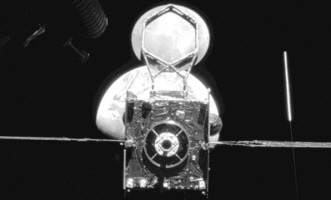Mission Extension Vehicle 1 (MEV-1) safely departs from Intelsat 901 (IS-901) in the Geosynchronous Earth Orbit (GEO) after providing five years of life extension service. The earth is visible in the background as well as MEV-1’s docking mechanism on the right. (Courtesy: Northrop Grumman’s Space Logistics)
MCLEAN, VA. -- Intelsat, operator of one of the world’s largest integrated satellite and terrestrial networks, became the first and only satellite operator to complete a life-extension mission adding five years of valuable service to the Intelsat 901 (IS-901) satellite and its many customers, providing extended reliable and global connectivity.
“The MEV mission proved that in-orbit servicing enhances satellite sustainability and efficiency in space,” said Jean-Luc Froeliger, SVP of Space Systems, Intelsat. “We were able to provide five additional years of reliable service to our Network, Media and Mobility customers and paved the way for future advancements in satellite servicing.”
The world’s first Mission Extension Vehicle (MEV), developed by Northrop Grumman Corporation’s (NYSE: NOC) Space Logistics LLC, successfully detached from IS-901 after moving the satellite to the graveyard orbit, where the satellite will be decommissioned after nearly 24 years of service. The MEV first docked with IS-901 in February of 2020 nearly 19 years after the satellite was first launched.
Geostationary satellites use propellant to remain at a specific orbital location, relocate to a new location or eventually be moved to a graveyard orbit. The MEV has its own propellant and thrusters that operate independently of the satellite. Through in-orbit docking, the MEV allows Intelsat to extend the life of a satellite by several years when the original propellant of that satellite has been depleted.
“Using the MEV to extend the life of IS-901 was a great commercial success for our customers, as well as a historic technical achievement,” Froeliger said. “We had to do a rendezvous and approach of two spacecraft moving at 3km per second,” Froeliger said.
Following this success, Intelsat partnered with Northrop Grumman on a second mission in 2021, using MEV-2 to extend the life of Intelsat 10-02, a combination that remains operational today. Intelsat continues to seek out and invest in next-generation satellite life-extension projects and other innovation setting the stage for continued advancements and enabling emerging space companies to shape the future of the industry.






